From Animal House to Our House
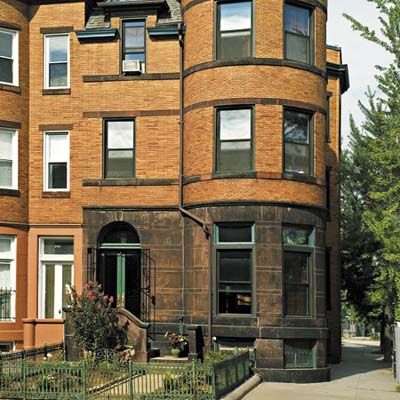
“This house will eat you alive.” That was the warning uttered by the real-estate agent I bought the roughed-up 1897 row house from—he also happens to be a licensed contractor. That was back in December 1999. The empty, three-story house, located on a corner lot in the Charles Village historic district of Baltimore, had suffered a decade’s worth of abuse at the hands of a rowdy fraternity so out of control that the city had cut off its utilities and filed lawsuits against it. Before that, the brick Queen Anne had managed to survive four owners and a century’s worth of wear and tear while remaining basically intact. But the kids didn’t really have any appreciation of that, taking a bat to the staircase balusters and using the doors for dart practice. The basement’s cedar closet was ripped to pieces and strewn about with other victims of the frat’s destruction: torn-off shutters, ripped-out door hardware, and shards of broken marble.
The terra-cotta-colored bricks on the 1897 Queen Anne row house’s facade needed repointing but were otherwise in good shape.
Team Effort
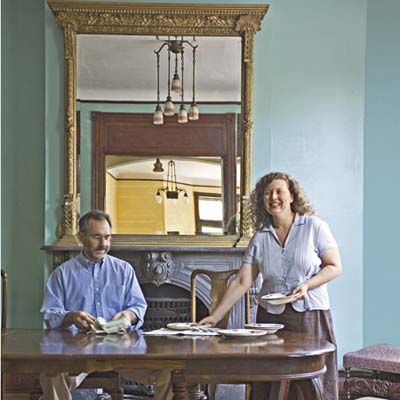
Considering my complete lack of rehab experience, I had grave doubts about taking on the project. But I had gone house-hunting with my new girlfriend, Jill—we were both writing professors at nearby Loyola College. Drawn together by our love of learning, antiques, and old homes, Jill and I had gone Dumpster-diving and flea-marketing together. So when she said she had her own toolbox and could help, I thought, “Gee, this could be fun.” We would end up getting married in this house, but not before seriously testing our relationship over missing tools, lead poisoning, and unfinished projects. My Realtor was right: I had no idea what we were in for.
Shown: To refurbish the dining room fireplace, which had been stripped of its details, we scoured auction houses, salvage shops, and neighbors’ garages for the slate mantel and mirror.
Before Fireplace
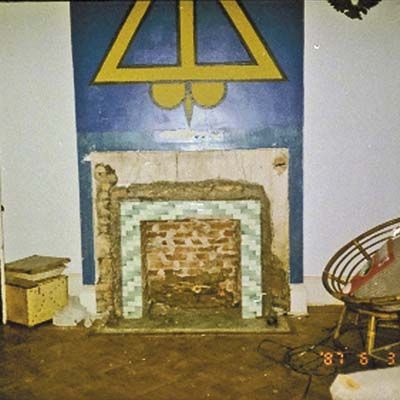
I bought the house in March 2000 “as is” because as battered as it was cosmetically, the 4,500-square-foot house was structurally solid and in a good neighborhood close to the university. I didn’t want to lose out to other prospective buyers. “As is,” though, meant inheriting a walk-in closet full of illicit term papers, three refrigerators full of leftovers, 16 empty beer kegs, a 20-foot bar, and far too many unflushed and clogged toilets. And oh, did I mention the room full of garbage? To-the-ceiling garbage.
It took a month just to clean out the house, filling 79 large garbage bags and three 30-yard Dumpsters. Since it was a historic home, I was able to get a tax credit from the city to help me bring it back. I thought that would be enough to hire all the contractors we would need, but after getting people in to refinish the floors, put in new windows, and update the plumbing and utility lines, I quickly started running out of money and, with a six-month deadline to get the place up to code, time. Of course, I wouldn’t find out until much later that you can get extensions for those kinds of loan requirements, so Jill and I ran ourselves into the ground during the first few months trying to get everything to pass inspection.
A Long Way Home
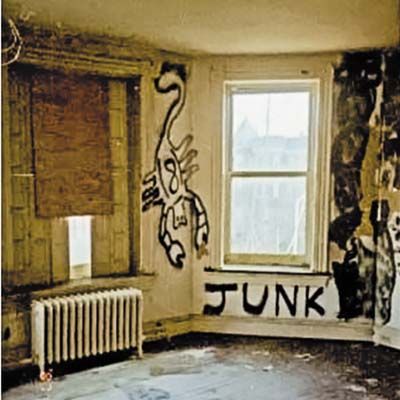
I moved in and started working 14-hour days, replastering the crumbling walls, stripping five layers of paint from the home’s trim, and running yards of electricity lines to new light fixtures. I bought 10 how-to books. The rest was learning through trial and error—like the first time I mixed plaster of paris, and it hardened before I could get it out of the bucket. Luckily, our Realtor-slash-contractor-slash-friend Nicholas Grant let me pay him to come by and teach me how to do things like replacing porch joists and installing a toilet.
It took me a while to get Jill to leave her rental and follow me, but I couldn’t blame her.
Library Graffitti
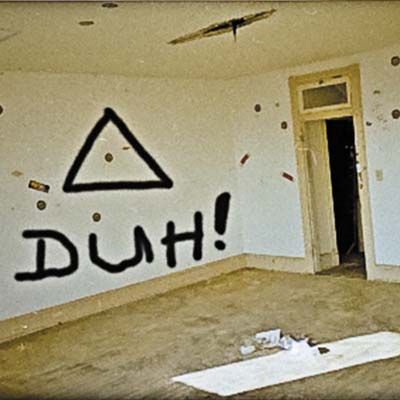
Looking back, I realize we were crazy to do what we did. We were just starting to figure out our relationship, and to throw in the stress of renovating a house made getting along a struggle. My idea was just to get the dang house up to code as soon as possible and then go back later to redo it the way we wanted, but Jill wanted to do it right from the beginning. I would find her breaking into a fireplace or tearing off a floorboard, and I’d get so upset because I didn’t think we had time to do those projects. I just wanted to get the walls and ceilings stabilized enough to pass code so that my home mortgage, which is tied to the rehab agreement, would drop to a lower, more reasonable rate. Of course, Jill had the foresight to know it would cost us more to do things over again later. We had a lot of arguments that year, but with time and patience, we learned how to work as a team.
Library
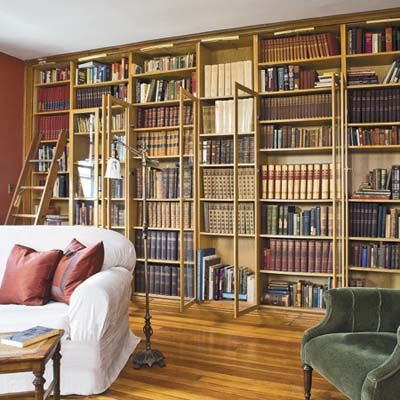
It ultimately took us a full year just to get the place up to code, but it still had plywood sheets nailed to the stairwell in place of balusters and lighting working in just half the house after I accidentally ripped out an important wire on the first floor. It wasn’t pretty. The next year was spent fixing up what we could cosmetically.
Shown: In an emptied third-floor bedroom, modified IKEA shelves ringed with vintage-style molding replaced a scrawled frat-house message. New bookcases store our collection of antique reference books and novels.
Lessons Learned
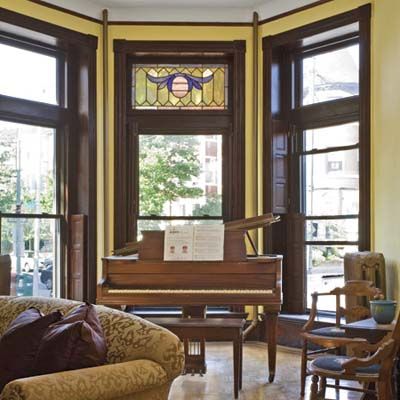
Over the years, Jill and I got braver with taking on projects, because we got desperate. I tried to hire someone to strip the paint from all of the pine and oak woodwork in the house, but the guy basically said I couldn’t pay him enough to take the project on. Jill and I really wanted to strip certain areas, however, so we decided to do it ourselves. We experimented with different chemicals, heating elements, and scrapers. We knew the paint was leaded, but we were so rushed and bogged down with other pressures that we weren’t careful. Jill would work without a mask, and I got so frustrated with the time-consuming process that I just took a belt sander to a windowsill one day. Needless to say, we both ended up with high levels of lead in our blood from breathing in lead dust. Jill, who had double the normal reading, got especially sick with headaches and fatigue, ending up on bed rest for a few weeks and having to give up that kind of work entirely. Any paint or chemical fumes still make her feel really ill. Since then, we’ve learned to use an infrared heat gun and to accept that we can’t get at all of the nooks and crannies in our 6-foot-high shutters, so we faux-paint some of the small areas to look like stained wood.
Shown: A salvaged stained-glass transom window overlooks a 1918 Chickering piano that we’re gradually restoring.
Beautified Bedroom
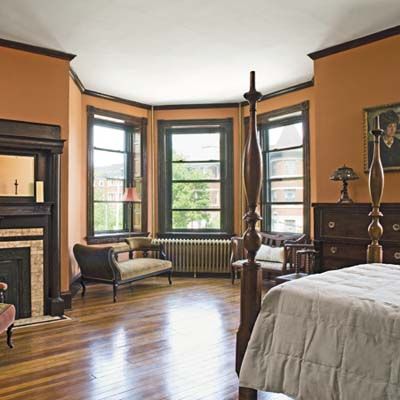
After replastering the bedroom’s graffiti-covered walls, Jill created thrifty, period-appropriate colors by blending paint from cans returned to the local Home Depot store.
Master Bath
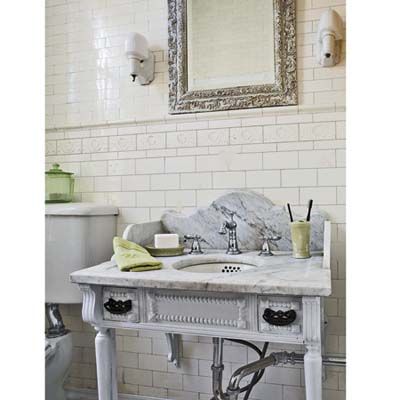
Vintage subway tile and an early-1880s barbershop marble sink were installed in the master bath. Glass shades from a salvage store finish off the original white ceramic sconces.
Steam Radiator
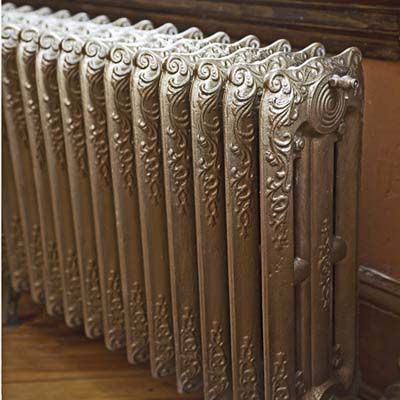
For months, we went through the jumble of parts in the basement to see what we could recover. Some things, like the vestibule doors and beadboard, were reusable; those that weren’t salvageable, like the original marble sink for the master bath, at least gave us a sense of what used to be in the house and a reason to go shopping.
Some of the few interior details to escape the fraternity’s destruction were
15 ornate cast-iron steam radiators, which we scraped, cleaned, and repainted in matte gold.
Salvage Shopping
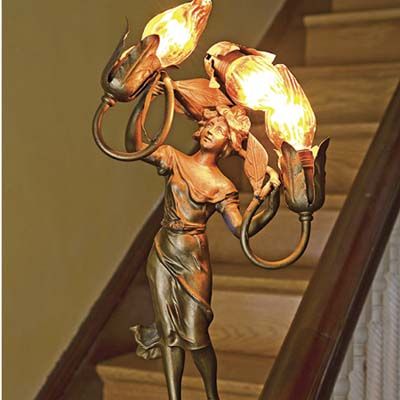
The most fun Jill and I have had during this process is trawling through auctions and salvage stores for period-appropriate details. We’ve come across some really great finds, including late-19th-century lights and great 3-by-6-foot mirrors for above the fireplaces.
Wiring runs from the basement through the newel post to light this ornate, late-19th-century pot-metal fixture.
Melding Old and New
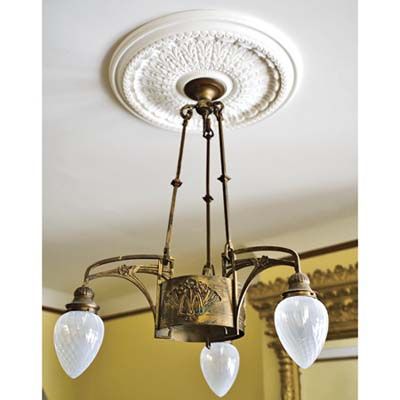
To give the new plastic ceiling medallion an aged look that blends with the 1920 ceiling fixture it surrounds, we plastered and then painted it.
Period Accents
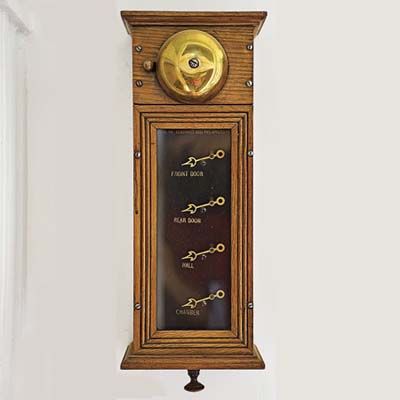
An era-appropriate 1890 servant’s register is wired to the doorbell; it replaces the original, which was likely sold off.
Staircase Revival
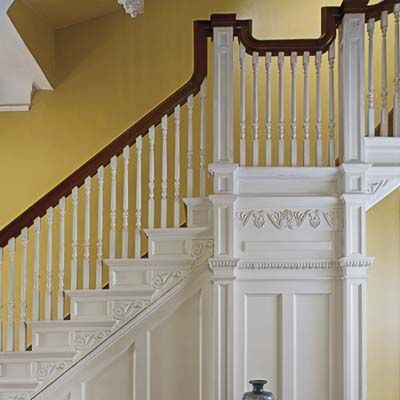
The moldings on this staircase are original, but the homeowners had to glue back together the mahogany banister, which had been hacked up; they also had 74 balusters reproduced to replace ones that had served as batting practice.
Every year since we got the house, we’ve learned to do something new and, we hope, better. Last year we finally reclaimed the backyard, which had been rat-infested until we built a second brick wall to close us off from a neglected, neighboring yard. Soon we’ll probably make it a full courtyard. Now, in our seventh year of working on the house, I tell people we’re almost done. Of course, Jill just rolls her eyes when she hears that. She knows that in an old house like this, you’re never really done. It’s one of the best lessons we’ve learned.
What We Did
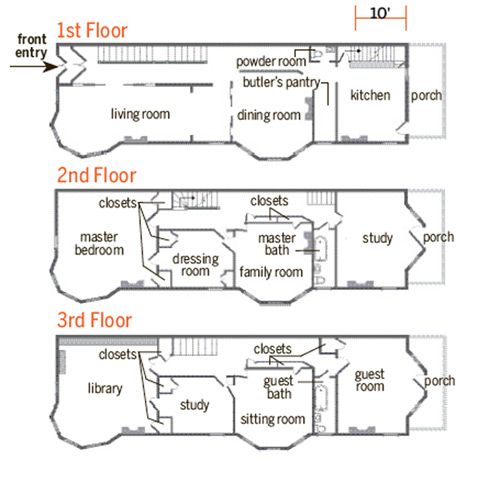
Remodeling Cost: $150,000
Time Frame: 7 years and counting
Where We Saved: Got building materials
at auctions and flea markets and learned how to do basic repair work, like plastering and running wires for new outlets,
by ourselves.
Where We Splurged: Buying some really nice era-appropriate lights and a late-19th-century mahogany table.
What We’d Do Differently: Salvage all of the wavy glass windows we replaced
and use them on the three-story porch. We would also have taken more time redoing the master bath, which has another remodel in its future now that we can do better tiling.
Biggest Challenge: On a personal level, just learning to work together. On the remodeling side, learning to strip paint effectively
and safely.
How We Solved It: Trial and error, plus a lot of patience for both.
